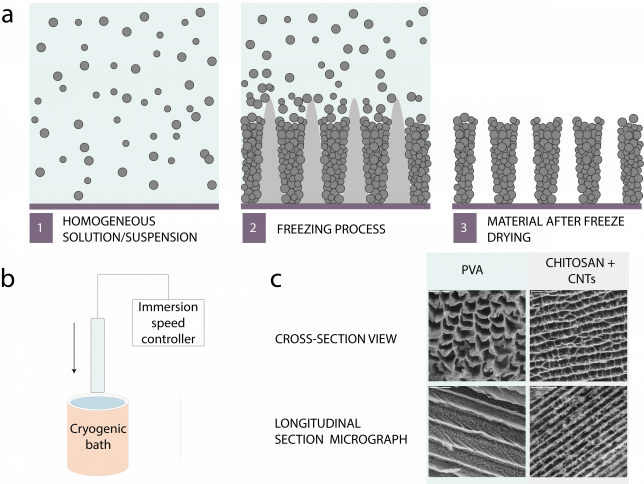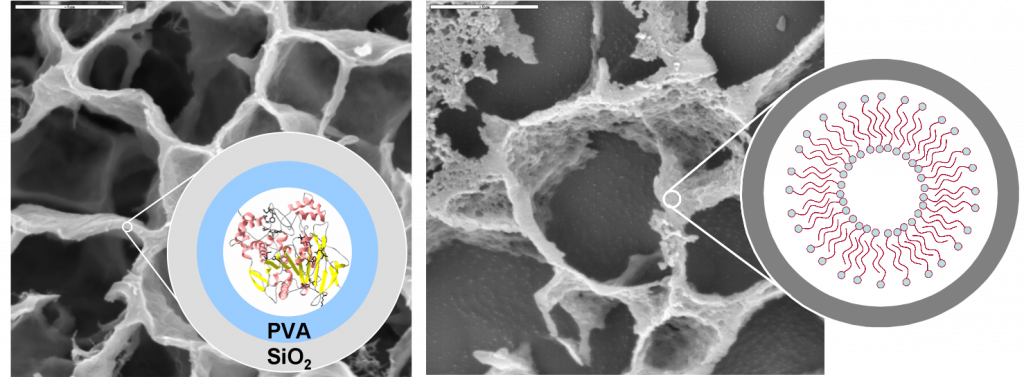Ice segregation induced self-assembly (ISISA) is a bottom-up process based on the unidirectional immersion in liquid nitrogen of a colloidal aqueous suspension and subsequent freeze-drying. The process has already demonstrated its suitability for the preparation of inorganic, organic and hybrid macroporous monoliths and fibers by freezing of different gels and colloidal suspensions. Moreover, the process is highly biocompatible (it begins from an aqueous suspension and continues in the absence of further chemical reactions avoiding potential complications associated with by-products or purification procedures) and its suitability for the incorporation of proteins, liposomes (e.g., membrane structures that mimics that of cells) and even bacteria has been demonstrated.

a – Scheme of the unidirectional freeze casting process, b – scheme of the ISISA system used in the Group of Bioinspired Materials and c – micrographs of scaffolds prepared by the ISISA method using poly(vinylalcohol) (PVA) and a mixture of chitosan and CNTs.
ISISA has been used for the preparation of materials with applications in energy, environmental science and biomedicine.
Moreover, monolithic 3D architectures composed of multiwall carbon nanotubes (MWCNT) and chitosan (CHI) proved highly effective as anodes in fuel cells and microbial fuel fells. Moreover, this sort of 3D architectures have demonstrated their suitability as scaffolds for tissue engineering purposes as well as supports for controlled release and drug delivery applications.

SEM micrographs of (left) the hierarchical structure (with organization at up to six different scales) resulting from pig liver estarase (PLE) immobilization within a PVA/SiO2 macroporous structure prepared via the ISISA process, and (rigth) the hierarchical structure (with organization at up to five different scales) resulting from liposomes immobilization within the a SiO2 macroporous structure prepared via the ISISA process.
SELECTED LIST OF PUBLICATIONS
- Highly efficient and recyclable carbon-nanofiber-based aerogels for ionic liquid–water separation and ionic liquid dehydration in flow-through conditions , R.
- Three Dimensional Macroporous Architectures and Aerogels Built of Carbon Nanotubes and/or Graphene: Synthesis and Applications
S. Nardecchia, D. Carriazo, M. C. Gutierrez, M. L. Ferrer, F. del Monte.
Chem. Soc. Rev. 2013, 42, 794 - Osteoconductive performance of carbon nanotube scaffolds homogeneously mineralized by flow-through electrodeposition
S. Nardecchia, M. C. Serrano, M. C. Gutierrez, T. Portoles, M. L. Ferrer, F. del Monte.
Adv. Funct. Mater. 2012, 22, 4411 - Three-dimensional microchanelled electrodes in flow-through configuration for bioanode formation and current generation
K. Katuri, M.L. Ferrer, M.C. Gutiérrez, R. Jiménez, F. de Monte, D. Leech. Energy Environ. Sci., 2011, 4, 4201 - Ice Templated Materials: Sophisticated Structures Exhibiting Enhanced Functionalities Obtained after Unidirectional Freezing and Ice Segregation Induced Self-Assembly M.C. Gutierrez, M. L. Ferrer, F. del Monte.
Chem. Mater. 2008, 20, 634 - Macroporous 3D Architectures of Self-Assembled MWCNT Surface Decorated with Pt Nanoparticles as Anodes for a Direct Methanol Fuel Cell
M.C. Gutiérrez, M.J. Hortigüela, J.M. Amarilla, R. Jiménez, M. L. Ferrer, F. del Monte J. Phys. Chem. C, 2007, 111, 5557–5560 - A Biocompatible Bottom-up Route for Preparation of Hierarchical Bio-Hybrid Materials
M. C. Gutierrez, M. Jobbagy, N. Rapun, M. L. Ferrer, F. del Monte.
Adv. Mater. 2006, 18, 1137 - Freezing of Binary Colloidal Systems for the Formation of Hierarchy Assemblies
M. L. Ferrer, R. Esquembre, I. Ortega, C. R. Mateo, F. del Monte.
Chem. Mater. 2006, 18, 554
